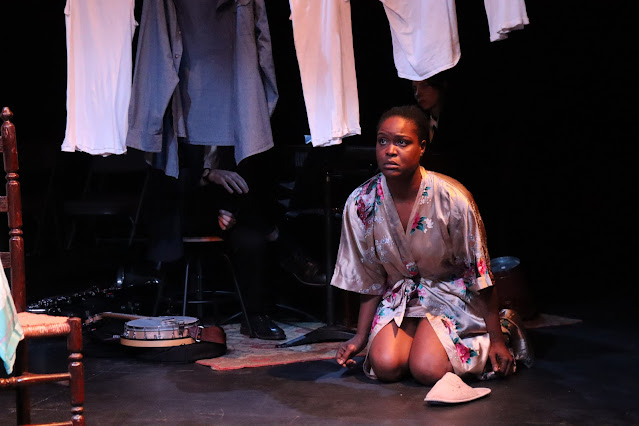Tin Church
Written and directed by Robyne Parrish
312 West 36th St., Floor 3, Manhattan, NYC
October 23-November 23, 2024
 |
Lilly Tobin, Virginia Wall Gruenert, Christina Perry, Marguerite Stimpson.
|
Tin Church opens the doors into its Southern Gothic world with a gradual drawing down of the lights to the atmospheric strains of musician
Adia Victoria's "
Where the Shadow Meets the Water," finally leaving the set in shadowy relief, with a seated woman silhouetted behind a scrim. This woman, we will learn, is mother of three Mildred (Virginia Wall Gruenert), one node in the matrix of intergenerational trauma movingly traced by
Tin Church, the first commissioned play and first full-length world premiere from actor, director, and playwright Robyne Parrish. Snatches of Victoria's song will recur, acting as one aural motif, with another a
tap tap tap that, in addition to signaling other thematically significant links that become clear as the play goes on, suggests a clock marking the passage of time, a constant and inescapable force in a production suffused with poignant ruminations on mortality, familial history, and cyclicity.
If the world of
Tin Church is Gothic, it is also female. Men play important roles in the lives and history of Mildred and her family, but they remain always offstage, vividly conjured (as are the previous generation of women) solely through the dialogue of Mildred and her daughters. The eldest of those daughters is Mary (Marguerite Stimpson), unmarried, child-free, and living in New York, far from her familial roots. As the play progresses, Mary's sisters, Linda (Christina Perry) and Sue (Lilly Tobin), who have both remained geographically close to their mother–one much closer than the other–fulfill the expectations to marry and have children, though not unproblematically in either case–and, by the end, the play will raise the question of whether Mary's different life choices will in fact allow her to escape the centrifugal, recursive unhappiness of her family. The death of Grandma Gilbert, Mildred's mother-in-law (from the side of the family whom Mildred avers never accepted her), is the first in the play's present, and Mildred and her daughters keep being reunited by funerals as play skips like a dream-laden stone through a couple of decades. Dreams are in fact another place where these women meet up (even memories prove permeable), with one sister even pointing out, in a dream, the lack of boundaries between dream and reality. Monologues from Mildred and Mary representing letters and journaling provide another, sometimes heightened, avenue of expression as well as exposition for these characters. From all of these avenues, the audience also assembles a picture of "Daddy," Mildred's husband, his inescapable effects on the lives of his wife and daughters and his very close, too close, relationship to his own mother, the aforementioned Grandma Gilbert.
 |
| Marguerite Stimpson |
The cast brings an effective uncanniness to the scenes of dream and memory woven through the play, including in a nightmarishly manic scene of the women rocking on the front porch, one instance of several in which the repetition of earlier lines of dialogue works both thematically and affectively. Stimpson lends a trance-like intonation to the child version of Mary; the play early on describes younger versions of the self as buried in past, an image that becomes important to Mary's dreaming, which is turn is described as a space where truth reigns and secrets are not allowed, quite unlike her waking world. The cast is equally engrossing as the women's waking selves, compellingly communicating, in each character's distinct manner, the tensions and anger that break through the surface of the usual pleasures and annoyances of being around family. The wooden frame in Marie Laster's scenic design suggests the bones of the family home, and the evocative sound design by Farid Vargas and lighting design by Juliette Louste, including an excellently realized thunderstorm sequence, enhance the impact of these performances as well as the sense that we are witnessing something like a great wheel grinding on.
In
Tin Church's depiction of the inevitable replacement of one generation by the next, the play explores the nexus of care, obligation, guilt, and damage at the (dark) heart of the family, the (limitations of) freedom to make one's own choices, struggles with mental health and medication, and, of course, mortality. The image of someone's hands betraying a fear of death otherwise concealed is a powerful one, one that–like certain snippets of music and dialogue in the production–pointedly recurs, and one that sits alongside the tin church itself as a symbol of this family's dynamic and emotional inheritance. Although
Tin Church concerns itself with various cycles, this production will only repeat itself for a certain time, so see it before it breaks its own performative loop.
-John R. Ziegler and Leah Richards





Comments
Post a Comment